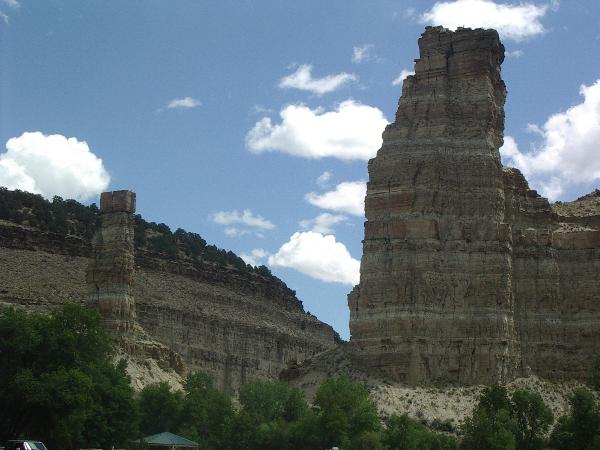Strawberry Pinnacles EarthCache
-
Difficulty:
-

-
Terrain:
-

Size:  (other)
(other)
Please note Use of geocaching.com services is subject to the terms and conditions
in our disclaimer.
The Strawberry Pinnacles are Sedimentary Rock Formations. 
SEDIMENTARY ROCKS FORMATION
Sedimentary rocks are formed in two ways. Some are formed by pressing together or compacting loose particles which have been deposited on land or in water bodies such as seas or lakes. These loose particles are called sediments. Other sedimentary rocks are formed by the crystallization of dissolved minerals.
BY COMPACTING SEDIMENTS

Sediments may be rock particles such as mud, sand or pebbles which are usually deposited in the sea by rivers and waves. They can also be remains of living things such as plants and animals. Gradually, over thousands or even millions of years, these sediments accumulate layer by layer, forming thick deposits on land or on the sea floor (SEE Fig 1). The weight of the overlying sediments will compact those found below. Over time, the compacted sediments become sedimentary rocks. Sometimes, these sedimentary rocks may be uplifted as a result of plate movements forming mountain, eg. The Himalayas.
BY CRYSTALLIZATION FROM DISSOLVED MINERALS

Fig 2: Crystallization of dissolved minerals in a shallow part of the sea.
The process of forming crystals from dissolved minerals usually occurs in the shallow parts of the sea or in lakes in desert areas where evaporation is much higher than precipitation. The sea or lake contains dissolved minerals such as calcium bicarbonate and calcium sulphate. As evaporation takes place, water is lost and the dissolved minerals from crystals which settle on the bottom of the sea of lake (SEE Fig 2). As evaporation continues, more crystals from and accumulate on the sea or lake floor, becoming sedimentary rocks.
Several types of rock are formed by the sedimentary process:
Shale:
Shale is lithified clay and consists of layers that typically break into thin sheets. type.
Sandstone:
Sandstone is composed of cemented sand grains and is the cliff-forming rock commonly seen in southern Utah.
Limestone:
Limestone is composed of more than 50% calcium carbonate (calcite). The remainder of the rock may contain fine rock fragments, clay, quartz, and seashells.
Conglomerate:
Conglomerate is well-rounded gravel in a matrix of sand, clay, and natural cementing agents.
So, How were the Pinnacles Formed?
My first thought of how these rock formations were formed was Lake Bonneville. As I researched Lake Bonneville, I found that it did not come this far East into the Uintah Basin.
The Pinnacles are near the confluence of the Strawberry River and Red Creek. Thousand of years ago the valley you are now standing in was once full of water. Look closely at the valley walls and you can see the "bath tub rings". They are different colored layers of sedimentary rock.
Later, a massive earth quake reformed the valley. The body of water was no longer. The erosion process then begun, and over thousands of years it formed the rock formations that stand before you today.
In order to log this cache, please do the following:
1) Take and post a picture to the cache page of yourself (or someone in your caching party) with the GPSr & the Pinnacles in the background. (Optional)
2) Send me an e-mail and include the following information:
The number# of people in your party.
The name of the resort you are at.
Which type of sedimentary rock make up the pinnicles?
Additional Hints
(Decrypt)
Ybbx Hc